Wondering how you can get your child to help around the house? These age appropriate chores for kids are a great place to start. Grab this free printable and get those kids to work!

Age Appropriate Chores For Kids
Not only is this free printable super helpful in thinking of things that need to be cleaned but it even breaks it down by age so that you know what your child can safely do.

And if your house is anything like my house…there’s some household chores that needs to be done. Rather than shoulder it all yourself and try to get it done, why not let the kids step up and help? After all, they’re living in it just as much as you are – if not more!
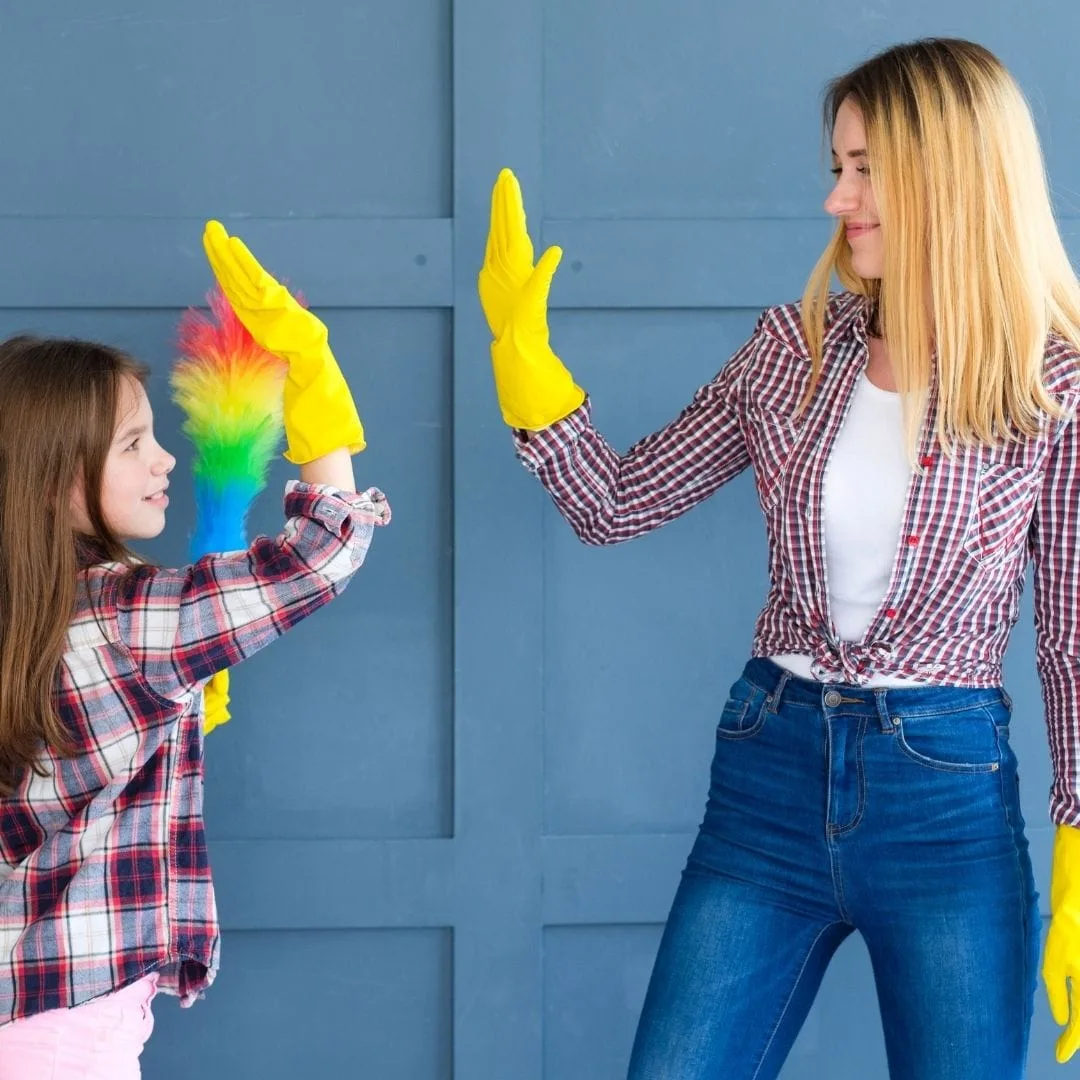
Don’t try to put the entire house cleaning option on your shoulders alone. Share it with the kids, too!
Getting Kids To Participate In Household Chores
Let’s face it…kids can all help clean from a young age once they’re able to safely walk about and not put things in their mouths.
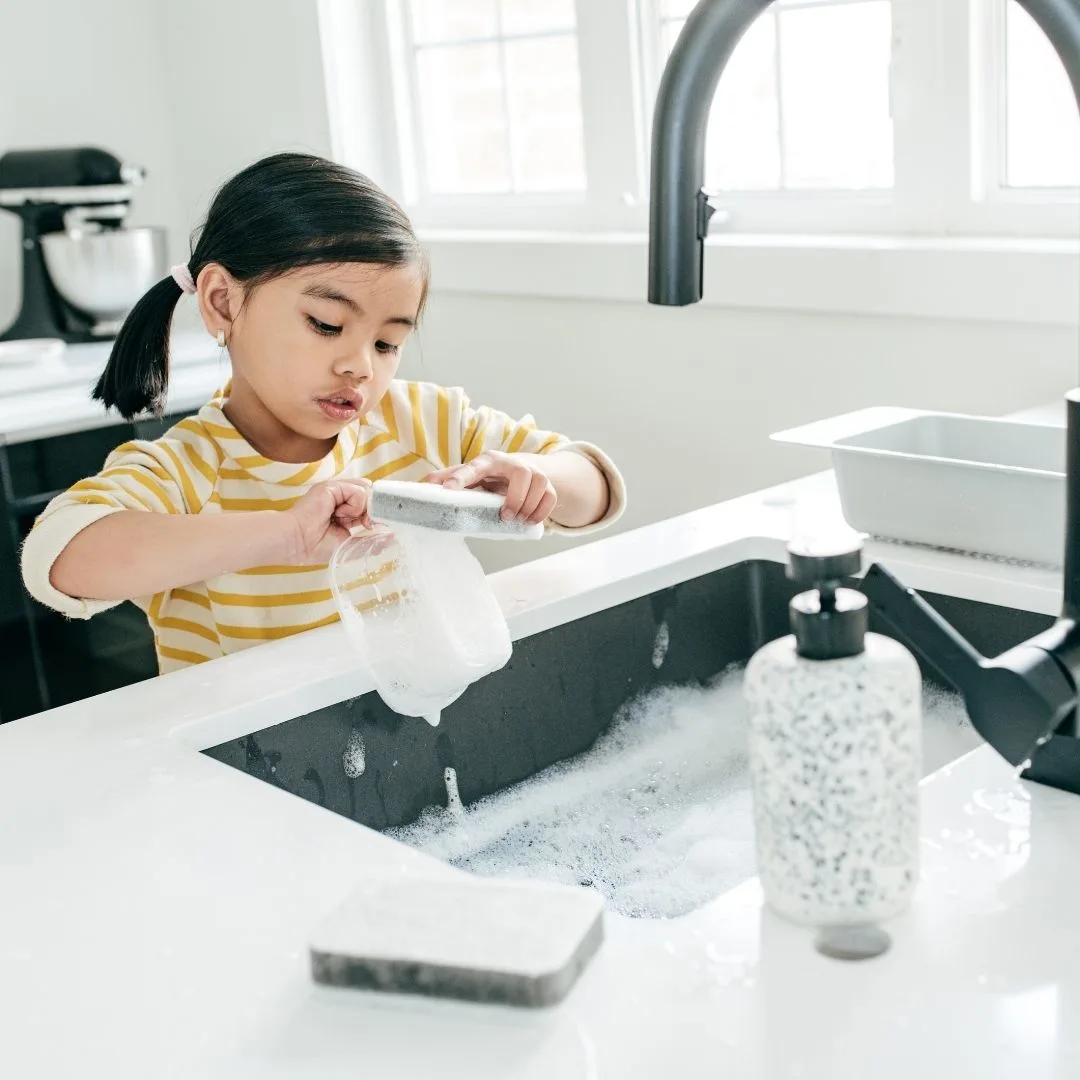
From about the age of 2 and up, they can easily help with wiping the bottoms of the windows or even cleaning the floor. The sooner that you can get them to help with the household tasks, the less work that you’re going to have to do!
If you’re worried that there is a chore that your child can’t help with, ask them what they’re comfortable with and go over the rules. Once they understand a bit more, they might be just fine with helping out with that cleaning task.

Getting kids starts with this type of responsibility at an early age sets up a great foundation for when they are older kids. Young children can do their own list of chores and learn some important life skills along the way!
This free printable starts with chores you can give 2 year olds to 14 years olds. By time they are in their teens you can get them to do their own laundry! I don’t know about you but I am happy to hand them over their dirty clothes.

How many chores daily should a child do?
This all comes down to what works well in your house. If you want your child to do 2 chores per day, have them do 2 chores per day. Understand their other commitments to work and activities and then try to find a good balance where they’re helping you and not getting worn out.
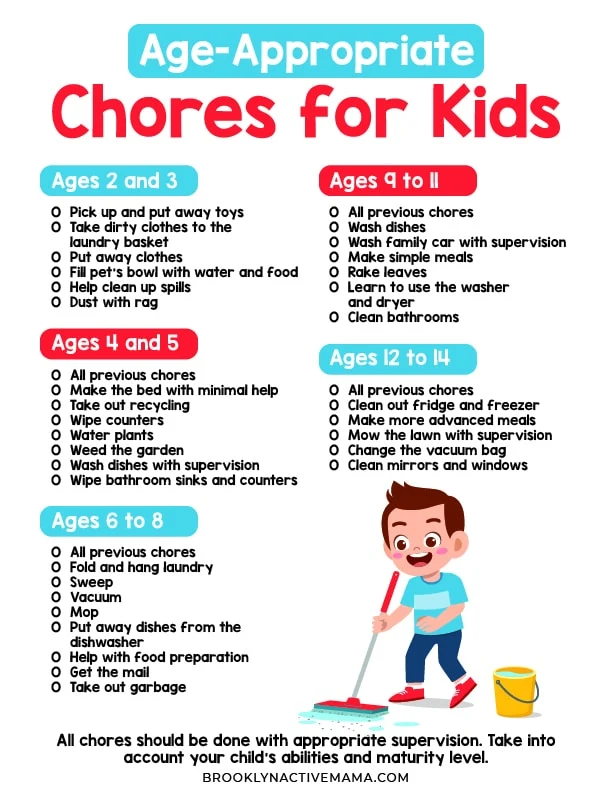
Giving your children chores with general guidelines can be really beneficial for everyone involved. The younger kids have small jobs that help out around the house like cleaning up toys in the living room.
Depending on the age group, young kids can really thrive doing some very simple tasks. It gives them a sense of responsibility and this free list of age-appropriate chores printable has some great ideas.

Why get my kid involved?
Every time you give a child a new task they learn important skills for the future. I used to be hesitant to teach my kids how to do things, but then I remembered that my mom taught me so much at such a younger age! The good news is that you can get them started wherever they are.
The best way to get kids involved in the early years is to give them small tasks such as taking out and putting away clothing. Older children may be a little be harder to wrangle but when you remain consistent, it will be a big help!
Children’s chores are an easy way to build good work ethic. You can have daily chores and add in new chores as you see fit. Each member of the family can can different types of chores.
The Importance of Age-Appropriate Chores for Kids
Chores can be an excellent way for children to learn responsibility, build good habits, and contribute to the family unit. However, it’s essential to assign chores that are appropriate for a child’s age and capabilities. Age-appropriate chores not only ensure that tasks can be completed effectively but also help in promoting a child’s development at each stage. Let’s take a closer look at some chores that are suitable for different age groups.
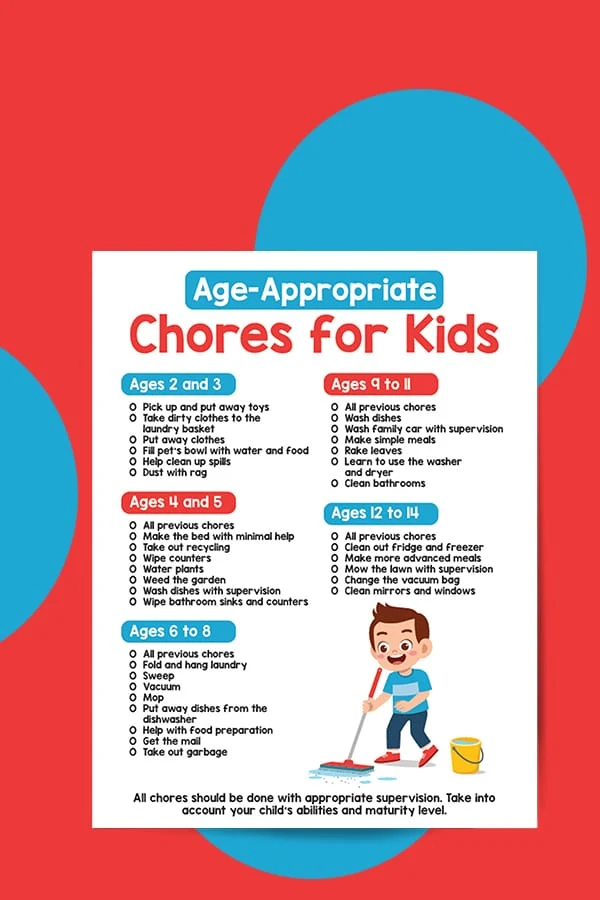
Toddlers: The Discovery Phase
For toddlers aged 2 to 3 years, the primary aim is to make chores feel like a fun activity rather than a task. At this age, kids love to mimic adults, so involving them in simple chores can be both educational and enjoyable. Examples include:
- Picking up toys
- Wiping up spills
- Dusting lower furniture surfaces
- Helping to water plants
The key is to make chores a game. You can make it more engaging by singing a cleanup song or making a game of who can pick up toys the fastest.
Preschoolers: Building Independence
Children aged 4 to 5 are generally more independent and capable of understanding simple two-step instructions. Chores at this stage can help in building their independence and motor skills. Suitable chores might include:
- Setting the table
- Sorting laundry colors
- Emptying waste bins
- Helping with pet care, like filling a water bowl
You can use sticker charts or a rewards system to make chores more exciting for preschoolers, reinforcing the concept that contributing to the household is both necessary and rewarding.
School-Age Children: Learning Responsibility
For kids aged 6 to 9, chores can be more complex and should focus on building a sense of responsibility. This age group is usually capable of:
- Sweeping floors
- Making their own beds
- Raking leaves
- Assisting in meal preparation, such as washing vegetables
At this age, children can start to appreciate the value of teamwork and understand that chores are a regular part of life. It’s also a good time to introduce an allowance or other rewards linked to chore completion, teaching them about the relationship between work and reward.
Pre-Teens and Teens: Preparing for Adulthood
Children aged 10 and older are capable of handling more challenging tasks and should be encouraged to contribute more significantly to household upkeep. Suitable chores for this age group can include:
- Doing the laundry
- Cooking simple meals
- Mowing the lawn
- Babysitting younger siblings
At this stage, chores can also serve as preparation for adulthood. Discuss the importance of each task, and how these skills will be useful later in life. You can also introduce more nuanced reward systems, such as saving up for something they want, which can impart valuable lessons about budgeting and delayed gratification.
The Importance of Consistency and Positive Reinforcement
Regardless of age, consistency is key. Make chores a regular part of your child’s routine, so they grow up understanding that such tasks are a normal part of life. Also, use positive reinforcement to encourage good behavior. Compliments, small rewards, or even simple high-fives can go a long way in making your child feel accomplished and valued.
In conclusion, age-appropriate chores can be an essential tool in your child’s development. They help instill a sense of responsibility, teach valuable life skills, and even prepare them for adulthood. The key is to choose chores that align with your child’s age and capabilities, and to make the experience as engaging and rewarding as possible.
It really depends on the maturity level too but whatever it takes to get to a clean house! This free printable chore chart is super helpful because it provides specific tasks on an age chore chart that can help you get some extra help around the house.
These age-appropriate chore ideas and super helpful when it comes to building kids responsibility. If you have children of different ages, this is a super efficient way to give the kids some great household responsibilities.
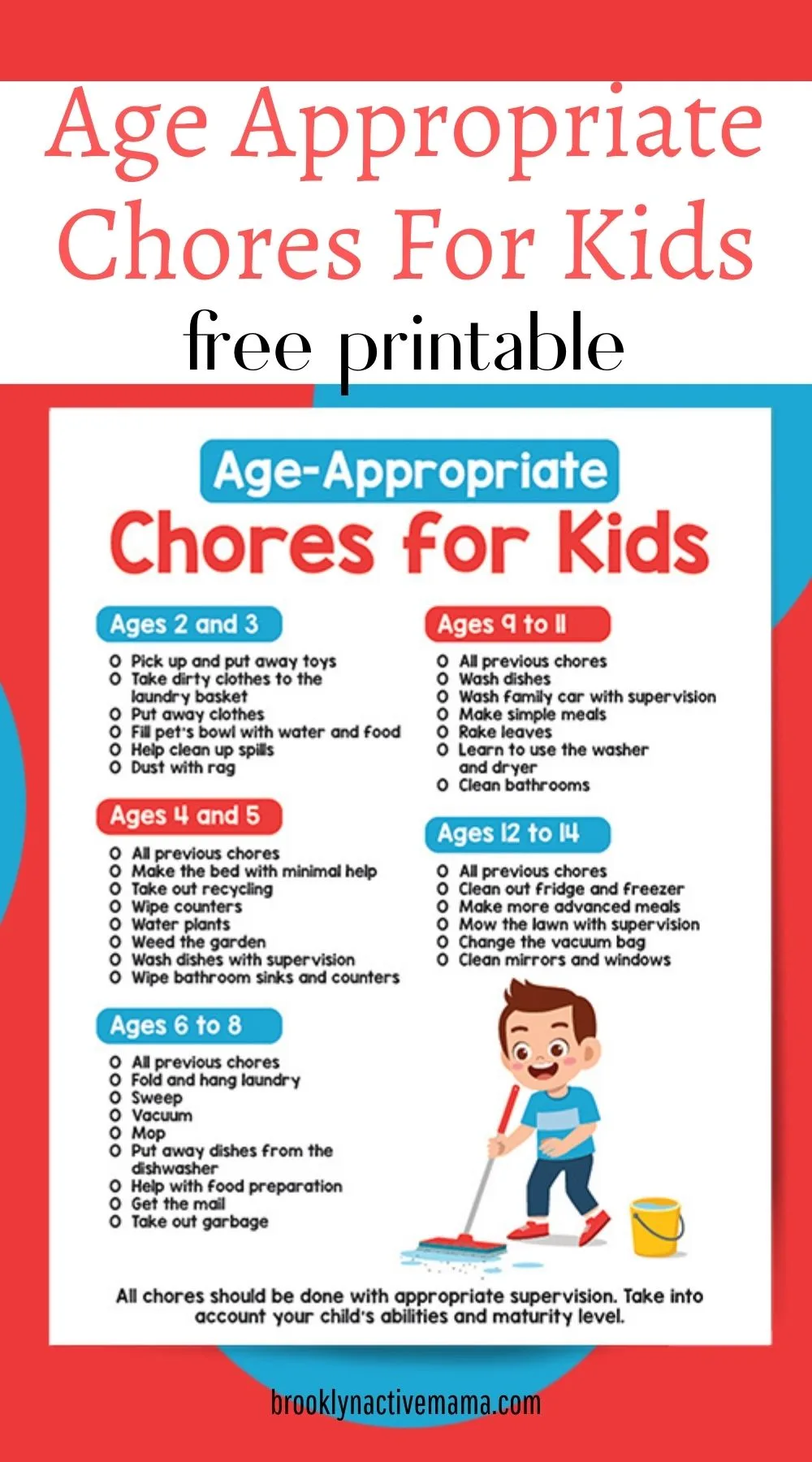
If you’re ready to start having more help around the house, using the chore chart is an awesome way to start. Each age is broken down with great suggestions on what your child can help clean.
Download your free Age Appropriate Chores Printable here
If you enjoyed this printable please let me know and tag me on Instagram!
For more great family printables check out:
- Free Printable Medical Planner For The Family
- Get Everyone Active With This Family Fitness Free Printable
- Mindfulness Activities For Kids – Free Printable
- Silly Questions To Ask Kids: Free Printable Sheet
- Dinner Conversation Starters: Free Printable Prompts
Hi! I’m Nellie. I am an entrepreneur, a busy mama of 3 and a wife to my high school sweetheart. I have been sharing content for over 12 years about how to cook easy recipes, workout tips and free printables that make life a little bit easier. I have been featured in places like Yahoo, Buzzfeed, What To Expect, Mediavine, Niche Pursuits, HuffPost, BabyCenter, Mom 2.0, Mommy Nearest, Parade, Care.com, and more!
Get comfortable and be sure to come hang out with me on social. Don’t forget to grab your free fitness journal before you go!
